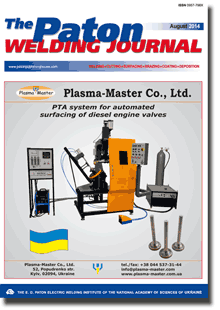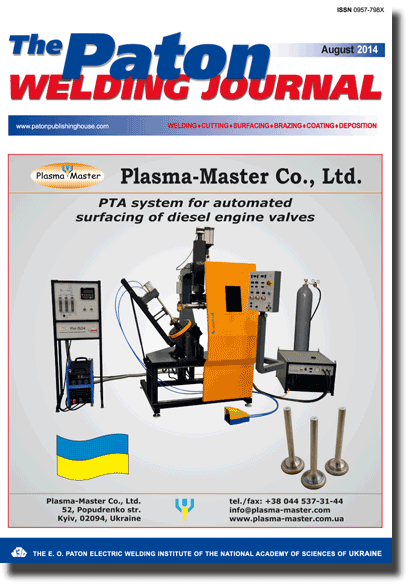| 2014 №08 (02) |
DOI of Article 10.15407/tpwj2014.08.03 |
2014 №08 (04) |

The Paton Welding Journal, 2014, #8, 21-25 pages
STRESS-STRAIN STATE AT FORCE AND TEMPERATURE LOADING OF ASSEMBLES FROM DISSIMILAR STEELS WITH SOFT INTERLAYER
I.A. KOLESAR and G.V. ERMOLAEV
Admiral Makarov National Shipbuilding University. 9 Geroev Stalingrada Ave., 54025, Nikolaev, Ukraine. E-mail: welding@nuos.edu.ua
Abstract
We have studied the stress-strain state (SSS) at loading by compression and temperature variation, in order to optimize the process of diffusion welding and brazing of assembles from dissimilar materials with soft interlayers. Materials having different thermal coefficient of linear expansion (TCLE) and the same moduli of elasticity were joined. An example of such joints can be those of magnetic and nonmagnetic steels produced with application of diffusion welding with soft interlayers or pressure brazing using filler metals based on copper with silicon, manganese and boron additives. Sufficient strength of materials in the brazed assembly is combined with plastic deformation of just the interlayer. Fields of all the components of stresses and strains, as well as their diagrams in different assembly sections were studied. Analysis of simulation results showed that tangential and equivalent stresses in the butt zone (on the interface), determining formation of physical contact and activation of the process of joint formation in diffusion welding, at simultaneous loading of assemblies with a soft interlayer rise considerably in material with higher TCLE at cooling and in material with lower TCLE at heating. Distribution of plastic deformations in the interlayer is more uniform, i.e. thermal cycling under pressure promotes formation of physical contact and activation of processes of joint formation in such assembles. 8 Ref., 10 Figures.
Keywords: diffusion welding, brazing, dissimilar materials, soft interlayers, SSS simulation, temperature and force loading
Received: 30.05.14
Published: 28.08.14
References
1. Kvasnitsky, V.V., Matvienko, M.V., Ermolaev, G.V. et al. Method of diffusion welding of materials. Pat. 81583 Ukraine. Int. Cl. B23K 20/14. Fil. 21.11.2006. Publ. 10.01.2008.
2. Kvasnitsky, V.V., Ermolaev, G.V., Matvienko, M.V. (2007) Principles of formation of stress-strain state in diffusion welding of dissimilar materials for cylinder-cylinder and bush-bush assemblies. Zbirnyk Nauk. Prats NUK, 5, 57-65.
3. Zhong, Z., Zhou, Z., Ge, C. (2004) Residual stress distribution and effect of interlayer in doped graphite/copper joints. Welding Technology, 6, 14-16.
4. Zhong, Z., Zhou, Z., Ge, C. (2009) Brazing of doped graphite to Cu using stress relief interlayers. J. Materials Proc. Techn., 209, 2662-2670. https://doi.org/10.1016/j.jmatprotec.2008.06.021
5. Makhnenko, V.I., Kvasnitsky, V.V. (2009) Stress-strain state of assemblies of the cylindrical shape in diffusion bonding. The Paton Welding J., 2, 2-7.
6. Makhnenko, V.I., Kvasnitsky, V.V. (2009) Peculiarities of formation of stress-strain state in diffusion bonds between dissimilar materials. Ibid., 8, 7-11.
7. Kvasnitsky, V.V., Ermolaev, G.V., Kolesar, I.A. (2011) Stress-strain state of welded and brazed joints of same rigidity dissimilar materials with interlayers. Zbirnyk Nauk. Prats NUK, 5, 36-43.
8. Kvasnitsky, V.V., Zolotoj, Yu.G., Labartkava, A.V. et al. (2008) Experimental investigation of deformation of welded joint of bush-bush type from dissimilar materials. Ibid., 4, 65-73.
Suggested Citation
I.A. KOLESAR and G.V. ERMOLAEV (2014) STRESS-STRAIN STATE AT FORCE AND TEMPERATURE LOADING OF ASSEMBLES FROM DISSIMILAR STEELS WITH SOFT INTERLAYER. The Paton Welding J., 08, 21-25.The cost of subscription/purchase order journals or individual articles
| Journal/Currency | Annual Set | 1 issue printed |
1 issue |
one article |
| TPWJ/USD | 384 $ | 32 $ | 26 $ | 13 $ |
| TPWJ/EUR | 348 € | 29 € | 24 € | 12 € |
| TPWJ/UAH | 7200 UAH | 600 UAH | 600 UAH | 280 UAH |
| AS/UAH | 1800 UAH | 300 UAH | 300 UAH | 150 UAH |
| AS/USD | 192 $ | 32 $ | 26 $ | 13 $ |
| AS/EUR | 180 € | 30 € | 25 € | 12 € |
| SEM/UAH | 1200 UAH | 300 UAH | 300 UAH | 150 UAH |
| SEM/USD | 128 $ | 32 $ | 26 $ | 13 $ |
| SEM/EUR | 120 € | 30 € | 25 € | 12 € |
| TDNK/UAH | 1200 UAH | 300 UAH | 300 UAH | 150 UAH |
| TDNK/USD | 128 $ | 32 $ | 26 $ | 13 $ |
| TDNK/EUR | 120 € | 30 € | 25 € | 15 € |
AS = «Automatic Welding» - 6 issues per year;
TPWJ = «PATON WELDING JOURNAL» - 12 issues per year;
SEM = «Electrometallurgy Today» - 4 issues per year;
TDNK = «Technical Diagnostics and Non-Destructive Testing» - 4 issues per year.


